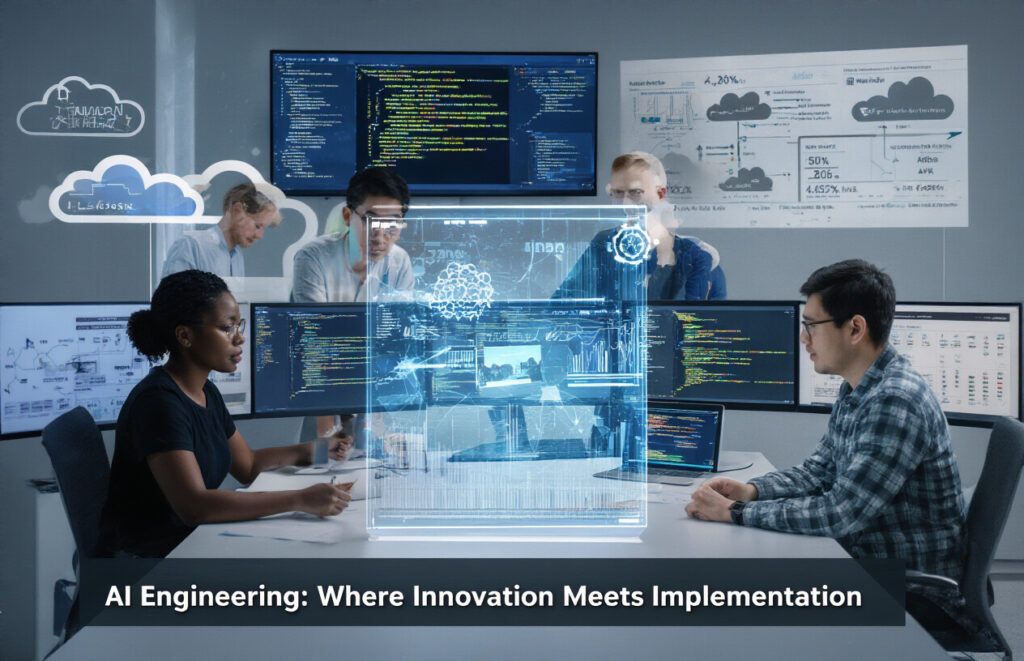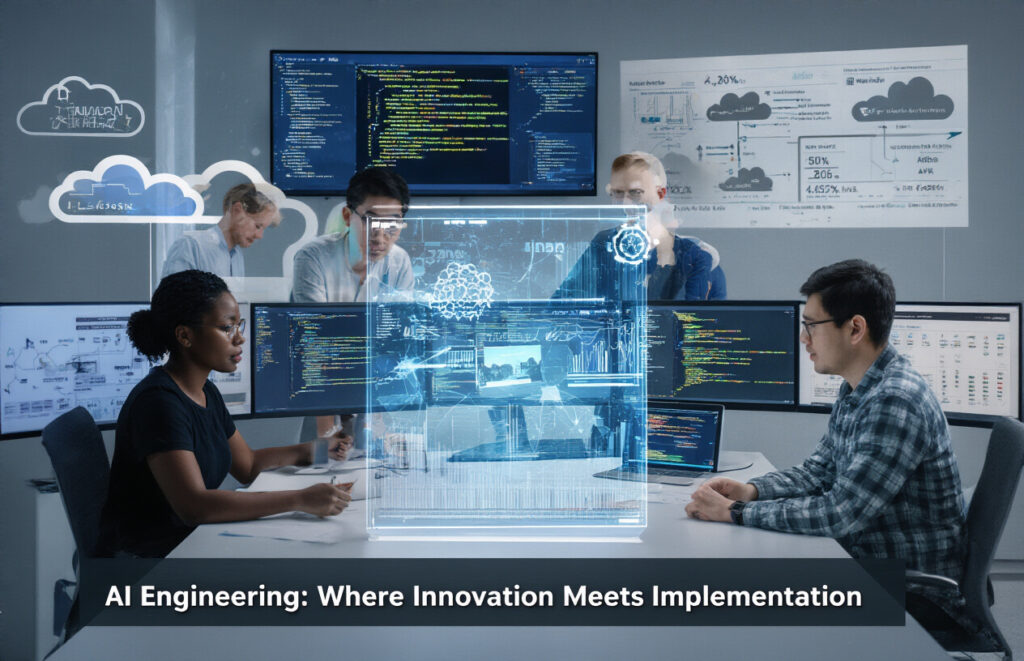What is AI Engineering

What is AI Engineering?
AI Engineering is the discipline that combines software engineering principles with machine learning to create reliable, scalable AI systems. For data scientists, software developers, and business leaders looking to implement AI solutions, understanding this field is essential. This guide will explore the AI Engineering lifecycle from development to deployment, and examine the core technical components that make AI systems work in production environments.
Defining AI Engineering

The Intersection of AI and Software Engineering
When you work in AI Engineering, you’re standing at the crossroads of two powerful disciplines. You’re not just writing code; you’re creating systems that can learn, adapt, and make decisions. This fusion requires you to think differently than traditional developers.
You need to understand both worlds: the structured approach of software engineering with its design patterns and testing methodologies, plus the experimental nature of AI with its models and algorithms. It’s like being bilingual in the tech world.
Every day, you’ll balance software architecture principles with machine learning frameworks. You might find yourself designing a scalable system in the morning and tuning neural network parameters in the afternoon. This dual expertise makes you incredibly valuable in today’s tech landscape.
How AI Engineering Differs from Traditional Software Development
Traditional software follows rules you explicitly define. Write the logic, test it, deploy it—done. But when you’re building AI systems, you’re creating something that generates its own rules from data.
You can’t just debug AI the way you debug regular code. When your model makes a wrong prediction, you won’t find a specific line of code to fix. Instead, you need to investigate your training data, model architecture, or hyperparameters.
Your development cycle looks different too:
| Traditional Development | AI Engineering |
|---|---|
| Requirements → Design → Code → Test | Problem Definition → Data Collection → Model Selection → Training → Evaluation → Deployment |
| Deterministic outputs | Probabilistic outputs |
| Fixed behavior after deployment | Continuous learning possible |
| Focus on software architecture | Balance of data science and architecture |
Key Skills Required for AI Engineers
To thrive as an AI Engineer, you need to expand your toolkit beyond traditional coding skills:
- Programming + Math: You’ll need strong coding skills (Python is your best friend) plus a solid understanding of linear algebra, calculus, and statistics.
- Data Wrangling: Most of your time will be spent preparing data. You need to clean, transform, and validate data efficiently.
- Machine Learning Knowledge: Understanding various algorithms, model selection techniques, and evaluation metrics is essential to your daily work.
- Software Engineering Practices: You still need to write maintainable code, use version control, and follow good architecture principles.
- MLOps Skills: You’ll deploy models to production and monitor them over time, requiring DevOps knowledge tailored to machine learning systems.
- Domain Expertise: The more you understand the industry you’re working in, the better AI solutions you’ll build.
- Ethical Awareness: You’re responsible for understanding the implications of the AI systems you create and mitigating potential harms.
The AI Engineering Lifecycle
Data collection and preparation
Ever wonder why some AI systems work like magic while others fall flat? It all starts with your data. Garbage in, garbage out – it’s that simple. When you’re building an AI solution, you need to gather massive amounts of relevant, high-quality data.
First, identify what data you actually need. Then figure out where to get it – whether that’s internal databases, public datasets, or through data partnerships. But collecting data is just the beginning.
You’ll spend way more time cleaning and preparing data than you might expect. This means dealing with missing values, removing duplicates, and fixing inconsistencies. Data labeling is another crucial step – you’re essentially teaching your AI what’s what by tagging examples.
Don’t forget about data privacy and ethical considerations. You need to ensure you’re complying with regulations like GDPR or CCPA.
Model selection and training
Picking the right model for your problem is like choosing the right tool for a job. You wouldn’t use a hammer to cut wood, right?
When selecting a model, consider:
- The nature of your problem (classification, regression, clustering)
- Available computational resources
- Required accuracy levels
- Interpretability needs
You can either build models from scratch or use pre-trained models through transfer learning, which saves you tons of time and resources.
During training, you’ll split your data into training, validation, and test sets. This helps you tune hyperparameters without overfitting – when your model memorizes the training data instead of learning general patterns.
Deployment and monitoring
So you’ve built an amazing model. Now what? Deployment is where many AI projects crash and burn.
You need to integrate your model into existing systems or create new interfaces. This might mean packaging it as an API, embedding it in a mobile app, or implementing it on edge devices.
Consider these deployment strategies:
- Cloud-based deployment for scalability
- On-premise solutions for data security
- Edge deployment for real-time applications
Once deployed, you can’t just walk away. You need robust monitoring systems to track performance metrics and detect when things go wrong. Set up alerts for model drift – when your model’s performance degrades because real-world data changes over time.
Continuous improvement and retraining
The work doesn’t stop after deployment. Real-world data evolves constantly, and your models need to keep up.
Establish a feedback loop to collect new data and user interactions. This helps you identify weak spots in your model’s performance.
Schedule regular retraining sessions based on:
- Performance degradation signals
- Significant changes in input data
- Accumulation of sufficient new training data
A/B testing new model versions against the current one helps you validate improvements before fully replacing the production model.
Remember, AI engineering isn’t a one-and-done process. It’s a continuous cycle of improvement, just like any software development. The difference? Your system gets smarter with every iteration.
Core Components of AI Engineering

A. Machine learning frameworks and tools
Ever tried building an AI system from scratch? Not fun. That’s why you need solid ML frameworks and tools. Think of frameworks like TensorFlow, PyTorch, and scikit-learn as your best friends in AI engineering. They handle the heavy lifting so you can focus on solving actual problems.
When picking your tools, consider what you’re building. Need deep learning power? PyTorch might be your go-to. Working with traditional ML algorithms? Scikit-learn has got your back. And if you’re deploying at scale, TensorFlow’s production capabilities are hard to beat.
Don’t forget about model development environments like Jupyter notebooks. They’re game-changers for quick experimentation and visualization before you commit to production code.
B. Cloud infrastructure for AI
Gone are the days when you needed a room full of expensive GPUs. Cloud platforms like AWS, Azure, and Google Cloud now put virtually unlimited AI power at your fingertips.
These platforms offer specialized services like AWS SageMaker, Azure ML, and Google’s Vertex AI that streamline your entire ML workflow. You can train massive models without managing a single server.
The beauty? You pay only for what you use. Training a model for a few hours? Just spin up the resources when needed and shut them down after. This flexibility is a game-changer for both startups and enterprises.
C. DevOps for AI systems
Your brilliant AI model is useless if it never makes it to production. That’s where MLOps comes in – it’s DevOps specifically for AI systems.
With MLOps practices, you’ll automate testing, deployment, and monitoring of your models. Tools like GitHub Actions, Jenkins, or specialized platforms like Kubeflow help you create reliable CI/CD pipelines for your AI systems.
The real magic happens when you implement continuous training – your models automatically retrain on new data, keeping them fresh and accurate without manual intervention.
D. Data pipeline management
AI is hungry for data, and feeding it properly is an art form. Your data pipelines need to collect, clean, transform, and deliver data efficiently.
Tools like Apache Airflow, Dagster, or Prefect help you orchestrate complex data workflows. They ensure your data processing is reliable, traceable, and repeatable.
The key is building pipelines that scale with your needs. Start simple, then add complexity as required. Well-designed data pipelines aren’t just technical necessities – they’re competitive advantages.
E. Model governance
With great AI power comes great responsibility. Model governance ensures your AI systems remain transparent, ethical, and compliant.
You’ll need systems to track model versions, document decisions, and monitor for bias or drift. Tools like MLflow for experiment tracking and model registry are essential.
Don’t treat governance as an afterthought. Build it into your process from day one. This means documenting data sources, validation methods, and model limitations. Your future self (and legal team) will thank you when stakeholders ask tough questions about how your AI makes decisions.
Business Impact of AI Engineering

Transforming Industries Through Automated Intelligence
You’ve probably noticed how AI is changing everything around you. The real game-changer isn’t just AI itself, but AI Engineering – the structured approach to deploying AI at scale. When you implement AI Engineering in your business, you’re not just adding a fancy tech tool; you’re completely reimagining how your operations work.
Take manufacturing, for example. Your production lines can now detect defects with 99% accuracy before products even leave the factory. Or in healthcare, you can predict patient readmissions days before symptoms appear. These aren’t futuristic scenarios – they’re happening right now for companies that have embraced proper AI Engineering practices.
Cost Reduction and Efficiency Gains
Wonder why your competitors suddenly seem to be outperforming you with fewer resources? They’ve likely figured out how to properly engineer AI solutions. When you implement AI Engineering correctly, you’ll see:
- 40-60% reduction in manual data processing tasks
- 25-30% decrease in operational costs
- 70% faster decision-making processes
The best part? Unlike traditional cost-cutting that just trims fat, AI Engineering creates compound efficiency. Your systems get smarter over time as they process more data, meaning your ROI actually improves year after year.
Creating New Products and Services
AI Engineering isn’t just about improving what you already do – it’s your ticket to offering things that weren’t possible before. You can now:
- Personalize customer experiences at an individual level, even with millions of users
- Predict market trends before they become obvious to competitors
- Create entirely new business models based on insights from previously untapped data
Companies that master AI Engineering aren’t just participants in their industries anymore – they’re redefining them. You’ve got a choice: disrupt or be disrupted.
Challenges in AI Engineering
Managing model drift and decay
You’ll face this reality sooner or later: your beautifully trained AI model will start making worse predictions over time. This is model drift, and it happens because the world changes while your model stays the same. Customer behaviors shift, market conditions evolve, and suddenly your model is working with outdated patterns.
To tackle this, you need monitoring systems that alert you when performance drops below thresholds. Set up regular retraining schedules based on your specific domain – financial models might need weekly updates, while others can go months. The key is proactive management rather than waiting for things to break.
Ethical considerations and responsible AI
Building AI isn’t just about making something that works – it’s about making something that works responsibly. You’re creating systems that impact real people’s lives.
Start by asking tough questions: Does your facial recognition system work equally well across different skin tones? Could your recommendation engine create harmful filter bubbles? Are you collecting more data than you actually need?
Responsible AI requires:
- Transparency in how decisions are made
- Fairness across different user groups
- Privacy protection by design
- Human oversight for high-stakes decisions
Scaling AI solutions
Getting an AI model working in your laptop environment is one thing. Scaling it to handle millions of users? That’s where things get tricky.
You’ll need to think about:
- Compute resources that grow with demand
- Latency requirements for real-time applications
- Batch processing for efficiency when immediate results aren’t needed
- Infrastructure that can handle spikes in traffic
Cloud providers offer managed services that help, but you’ll still need to optimize your models specifically for production environments.
Talent acquisition and team building
The perfect AI engineering team isn’t just a bunch of data scientists. You need a mix of skills:
- Data engineers to build reliable data pipelines
- ML engineers who understand both code quality and model quality
- Subject matter experts who understand the business problem
- DevOps professionals who can automate deployment
- Product thinkers who connect technical solutions to user needs
When building your team, look beyond technical skills. The best AI engineers are curious, adaptable, and comfortable with ambiguity – because you’re solving problems that don’t have textbook answers yet.
Getting Started with AI Engineering

Essential Educational Pathways
Starting your AI engineering journey doesn’t have to be complicated. If you’re looking to break into this field, you’ve got several paths to choose from. A bachelor’s degree in computer science, data science, or mathematics can give you the foundation you need. But don’t worry if you don’t have a formal degree – many successful AI engineers are self-taught.
Online courses and bootcamps are game-changers. Platforms like Coursera, edX, and Udacity offer specialized AI and machine learning courses. These can fast-track your learning without the time and financial commitment of a traditional degree.
Want to go deeper? Consider a master’s or PhD in machine learning, AI, or computational linguistics. These advanced degrees can open doors to research positions and higher-paying roles.
Remember, what matters most is your skills, not just your credentials. Focus on building a strong understanding of:
- Programming (Python, R, Java)
- Statistics and probability
- Linear algebra and calculus
- Machine learning algorithms
- Neural networks and deep learning
Building a Portfolio of AI Projects
Nothing speaks louder than real projects. Your portfolio is your ticket to landing interviews and standing out from other candidates.
Start small with beginner-friendly projects like:
- A simple image classifier
- A sentiment analysis tool for tweets
- A recommendation system for movies or products
As you grow your skills, tackle more complex challenges:
- Natural language processing applications
- Computer vision systems
- Reinforcement learning models
GitHub is your best friend here. Create a clean, well-documented repository for each project. Include clear READMEs explaining your approach, the problems you solved, and the results you achieved.
Don’t just build – share your work! Write blog posts about your projects, create YouTube tutorials, or present at local meetups. This showcases not just your technical abilities but also your communication skills – something employers value tremendously.
Tools and Platforms for Beginners
The right tools make all the difference when you’re starting out. Here’s what you should get familiar with:
Programming Languages:
- Python (the undisputed king of AI development)
- R (great for statistical analysis)
- Julia (gaining popularity for its speed)
Libraries and Frameworks:
- TensorFlow and PyTorch for deep learning
- Scikit-learn for traditional machine learning
- Pandas and NumPy for data manipulation
- Matplotlib and Seaborn for visualization
Development Environments:
- Jupyter Notebooks for interactive coding
- Google Colab for free GPU access
- VS Code with Python extensions
Cloud Platforms:
- AWS SageMaker
- Google Cloud AI Platform
- Microsoft Azure Machine Learning
Don’t try to master everything at once. Pick a language (Python is recommended), a few key libraries, and a development environment. Then start building. You’ll pick up other tools as needed for specific projects.
Many of these platforms offer free tiers or student accounts, so you can practice without breaking the bank. Take advantage of these resources to experiment and learn by doing.

Embracing the AI Engineering Journey
AI Engineering has emerged as a critical discipline that bridges the gap between AI research and practical application. Through a structured lifecycle approach, it combines data engineering, ML modeling, and robust deployment to create sustainable AI systems. Organizations embracing AI Engineering principles can expect improved operational efficiency, enhanced decision-making capabilities, and competitive advantages in their respective industries.
As AI continues to transform businesses across sectors, developing AI Engineering competencies becomes increasingly vital. Despite challenges like data quality issues and model governance requirements, the journey toward AI maturity is accessible through gradual implementation, continued learning, and organizational adaptation. By investing in AI Engineering practices today, companies position themselves at the forefront of innovation, ready to harness the transformative potential of artificial intelligence in solving complex business problems.

